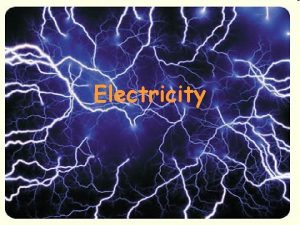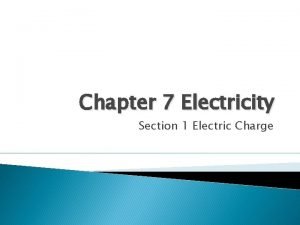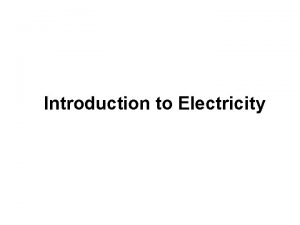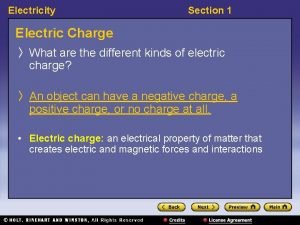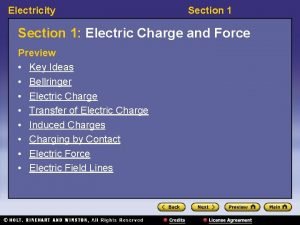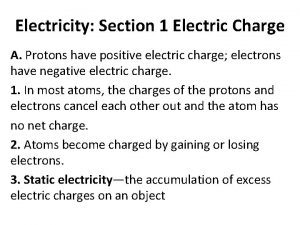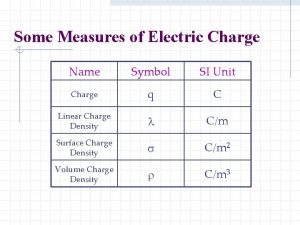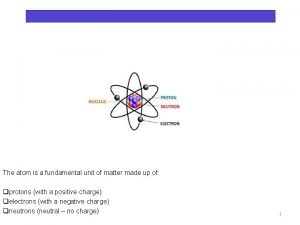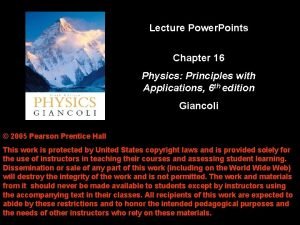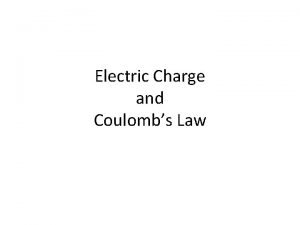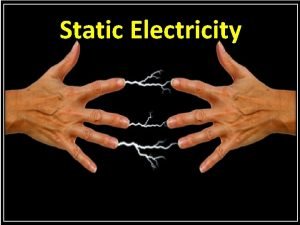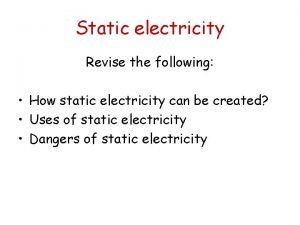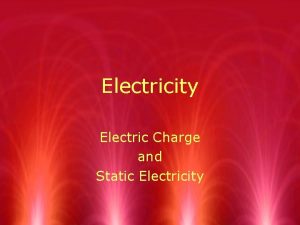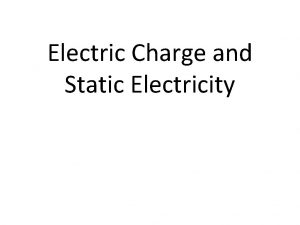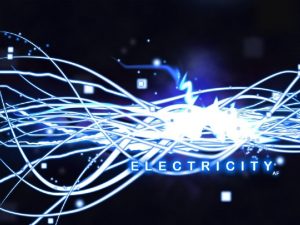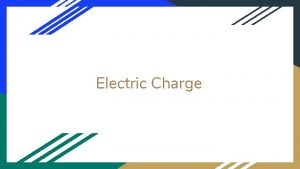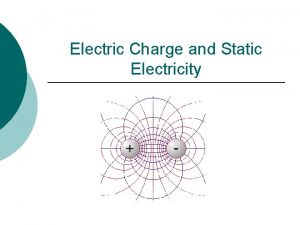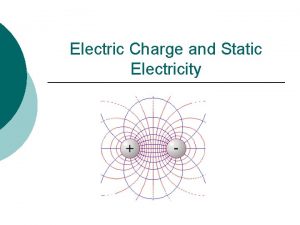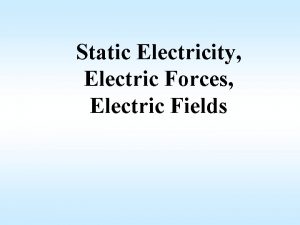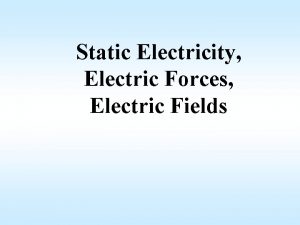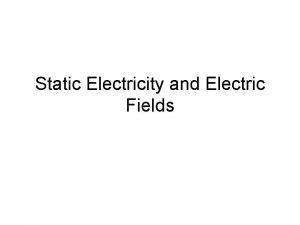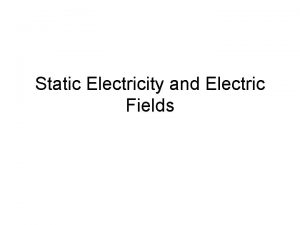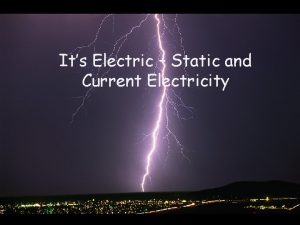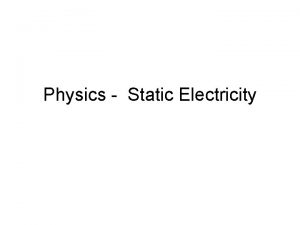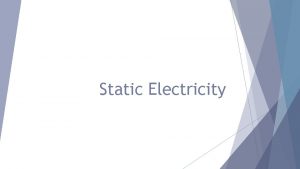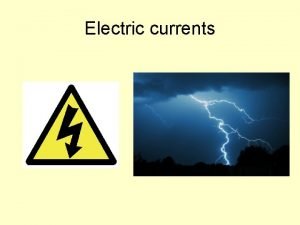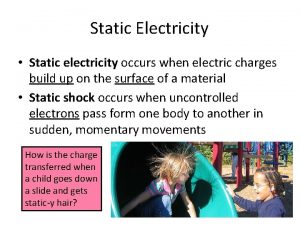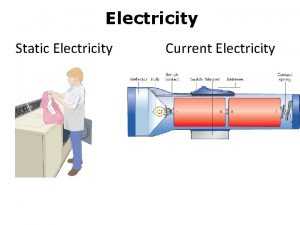Electric Charge and Static Electricity Unit 10 Section























- Slides: 23

Electric Charge and Static Electricity Unit 10 Section 1

I. Law of Electric Charges a. The Law of Electric Charges states that like charges repel, or push away. b. It also states that unlike charges attract. c. This is just how magnets work too.

II. What is an Atom? a. An atom is the smallest unit of an element that maintains the properties of that element.

• Atoms Family • http: //www. youtube. com/watch? v=Di. PPw. DAk 1 Q

III. Parts of an Atom a. Protons are positively charged (think protons=positive both start with “P”. b. Electrons are negatively charged. c. Because protons and electrons have opposite charges, they are attracted to each other…”opposites attract”. d. Neutrons do not have any electrical charge (think neutral).

IV. Electric Field and Electric Force a. The force between charged objects is electric force. b. The size of the force depends on: 1. The amount of charge on each object. 2. The distance between the charges. c. An electric field is the region (area)around a charged object.

V. Conduction and Induction a. Conduction is when electrons move from one object to another by direct contact. An example is touching a glass rod to an uncharged piece of metal.

b. Induction is when charges in an uncharged metal object are rearranged without direct contact. An example is holding a metal object near a charged object. Pg. 476

VI. 3 Ways to Charge an Object • There are equal numbers of electrons and protons in a neutral matter. If something changes this balance we can say it is charged. a. Friction b. Conduction c. Induction

VII. Static Electricity a. Static electricity is the electric charge at rest. b. It is produced by friction or induction. c. When you get up from your seats in class, friction from your body on the seat produces static electricity.

VIII. Electrical Conductors and Insulators a. An electrical conductor is a material in which charges can move through easily. Most metals are good conductors, especially copper, aluminum, and mercury. b. An electrical insulator is a material in which charges cannot move easily. Plastic, rubber, glass, wood, and air are good insulators.

IX. Electric Discharge a. The release of electricity stored in a source is known as an electric discharge. b. This can happen slowly, as when clothes that stick together stop sticking together over time or it can happen quickly, like when you get a shock. c. Lightning is an electrical discharge.

X. Lightning Dangers a. Lightning usually strikes the highest point in a charged area. b. Do not stand near a tree in a storm. The lightning can leap from the tree to you. c. A lighting rod is a rod connected to the ground by wire. They are good for attracting lighting bolts into earth and away from buildings.

Quickie Quiz 1. Positive and negative charges will: a. b. c. d. Attract Repel Attract and repel None of the above

Quickie Quiz 1. Positive and negative charges will: a. b. c. d. Attract Repel Attract and repel None of the above

Quickie Quiz 2. Protons are: a. positively charged b. negatively charged c. both positively and negatively charged d. neither positively or negatively charged

Quickie Quiz 2. Protons are: a. positively charged b. negatively charged c. both positively and negatively charged d. neither positively or negatively charged

Quickie Quiz 3. An electric field is: a. The force between charged objects. b. A place you play in a storm. c. The region around a charged object. d. A lit up baseball diamond.

Quickie Quiz 3. An electric field is: a. The force between charged objects. b. A place you play in a storm. c. The region around a charged object. d. A lit up baseball diamond.

Quickie Quiz 4. Good conductors of electricity are: a. copper and aluminum b. paper and cardboard c. glass and rubber d. none of the above

Quickie Quiz 4. Good conductors of electricity are: a. copper and aluminum b. paper and cardboard c. glass and rubber d. none of the above

Quickie Quiz • 5. Good insulators of electricity are a. b. c. d. metal and iron copper and metal iron and steel Rubber and cloth

Quickie Quiz • 5. Good insulators (don’t allow electricity to flow) of electricity are a. b. c. d. metal and iron copper and metal iron and steel Rubber and cloth
 Chapter 6 section 1 electric charge worksheet answers
Chapter 6 section 1 electric charge worksheet answers Electricity section 1 electric charge
Electricity section 1 electric charge Electricity section 1 electric charge
Electricity section 1 electric charge Static electricity and current electricity
Static electricity and current electricity Current electricity gif
Current electricity gif How are static electricity and current electricity alike
How are static electricity and current electricity alike Difference between charge and electric charge
Difference between charge and electric charge Difference between charge and electric charge
Difference between charge and electric charge Chapter 21 electric charge and electric field
Chapter 21 electric charge and electric field Chapter 21 electric charge and electric field
Chapter 21 electric charge and electric field Chapter 16 electric charge and electric field
Chapter 16 electric charge and electric field Units of a charge
Units of a charge Chapter 17 section 1 electric charge and force answer key
Chapter 17 section 1 electric charge and force answer key Inductor water analogy
Inductor water analogy Section 1 electric charge crossword puzzle answers
Section 1 electric charge crossword puzzle answers Section 1 electric charge
Section 1 electric charge Example of charge by contact
Example of charge by contact Surface charge density symbol
Surface charge density symbol Units of electric charge
Units of electric charge Unit of electric charge
Unit of electric charge Coulomb's law force between two point charges
Coulomb's law force between two point charges Static electricity
Static electricity Static electricity
Static electricity Bill nye friction worksheet
Bill nye friction worksheet

